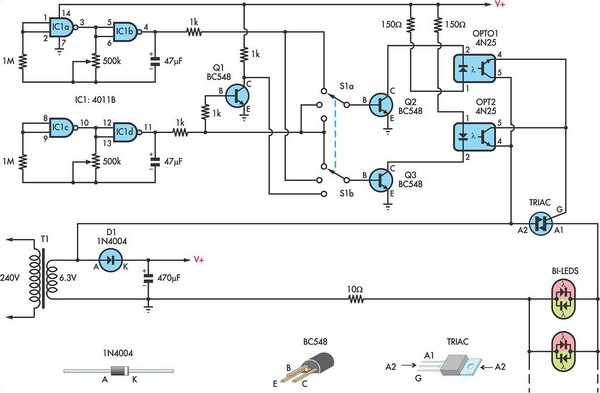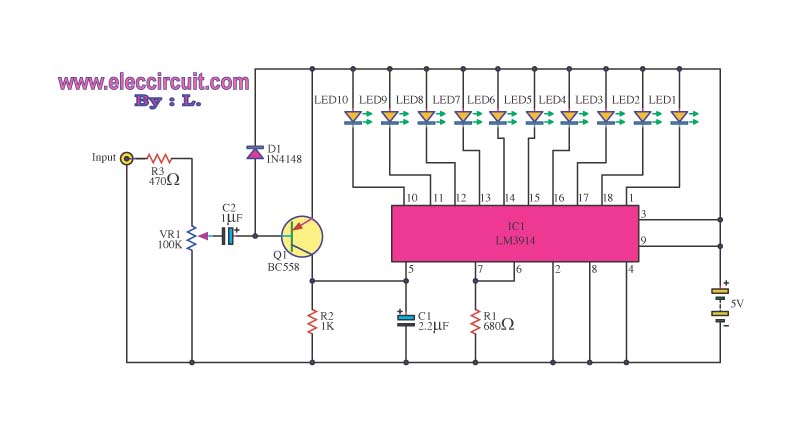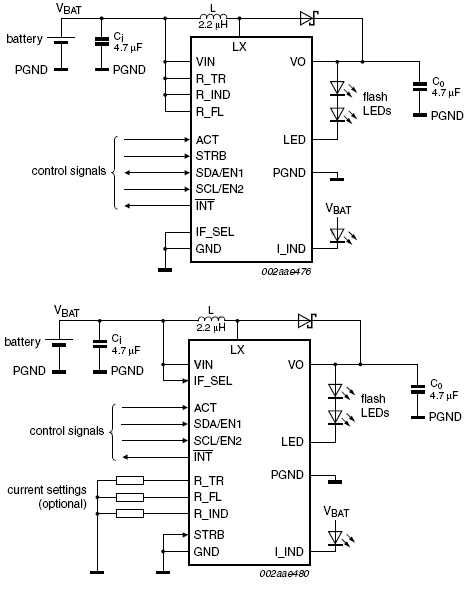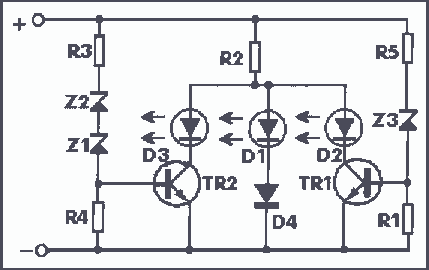
led vu meter
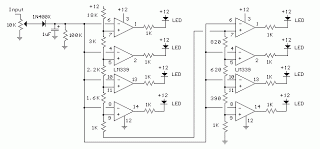
The circuit utilizes two quad voltage comparators (LM339) to illuminate a series of eight LEDs that indicate volume levels. Each of the eight comparators is biased at increasing voltages determined by a voltage divider, allowing the lower right LED to activate first when the input reaches approximately 400 millivolts, which corresponds to about 22 milliwatts peak in an 8-ohm system. The voltage divider settings ensure that each LED represents roughly double the power level of the preceding one, resulting in a scale that ranges from 22 milliwatts to approximately 2.5 watts when all LEDs are illuminated. The sensitivity can be adjusted using an input control to accommodate higher power levels.
The circuit employs the LM339, a quad comparator that is well-suited for low-voltage applications. The comparators are configured to compare the input voltage against reference voltages generated by the voltage divider network. This network consists of resistors arranged to create a series of reference voltages, each incrementally higher than the last. The first comparator activates when the input voltage exceeds 400 millivolts, turning on the first LED. Subsequent comparators are set to activate at progressively higher voltage thresholds, effectively doubling the power level represented by each LED.
The power levels indicated by the LEDs are crucial for applications where visual feedback of volume is necessary, such as in audio equipment. The design allows for a clear visual representation of the audio power levels, making it easier for users to monitor and adjust settings. The adjustable input control provides flexibility, enabling the circuit to be tuned for different audio systems or user preferences.
In terms of implementation, care must be taken to ensure that the voltage divider is accurately set to achieve the desired thresholds. The use of precision resistors is recommended to maintain consistency in the reference voltages. Additionally, the circuit should be tested under actual operating conditions to validate its performance and responsiveness to varying input levels. Proper power supply decoupling is also advised to mitigate any potential noise that could affect the comparator operation.The circuit below uses two quad voltage comparators (LM339) to illuminate a series of 8 LEDs indicating volume level. Each of the 8 comparators is biased at increasing voltages set by the voltage divider so that the lower right LED comes on first when the input is about 400 millivolts or about 22 milliwatts peak in an 8 ohm system.
The divider vol tages are set so that each LED represents about twice the power level as the one before so the scale extends from 22 milliwatts to about 2. 5 watts when all LEDs are lit. The sensitivity can be decreased with the input control to read higher levels. I have not built or tested this circuit, so please let me know if you have problems getting it working.
The power levels should be as follows: 🔗 External reference
The circuit employs the LM339, a quad comparator that is well-suited for low-voltage applications. The comparators are configured to compare the input voltage against reference voltages generated by the voltage divider network. This network consists of resistors arranged to create a series of reference voltages, each incrementally higher than the last. The first comparator activates when the input voltage exceeds 400 millivolts, turning on the first LED. Subsequent comparators are set to activate at progressively higher voltage thresholds, effectively doubling the power level represented by each LED.
The power levels indicated by the LEDs are crucial for applications where visual feedback of volume is necessary, such as in audio equipment. The design allows for a clear visual representation of the audio power levels, making it easier for users to monitor and adjust settings. The adjustable input control provides flexibility, enabling the circuit to be tuned for different audio systems or user preferences.
In terms of implementation, care must be taken to ensure that the voltage divider is accurately set to achieve the desired thresholds. The use of precision resistors is recommended to maintain consistency in the reference voltages. Additionally, the circuit should be tested under actual operating conditions to validate its performance and responsiveness to varying input levels. Proper power supply decoupling is also advised to mitigate any potential noise that could affect the comparator operation.The circuit below uses two quad voltage comparators (LM339) to illuminate a series of 8 LEDs indicating volume level. Each of the 8 comparators is biased at increasing voltages set by the voltage divider so that the lower right LED comes on first when the input is about 400 millivolts or about 22 milliwatts peak in an 8 ohm system.
The divider vol tages are set so that each LED represents about twice the power level as the one before so the scale extends from 22 milliwatts to about 2. 5 watts when all LEDs are lit. The sensitivity can be decreased with the input control to read higher levels. I have not built or tested this circuit, so please let me know if you have problems getting it working.
The power levels should be as follows: 🔗 External reference
